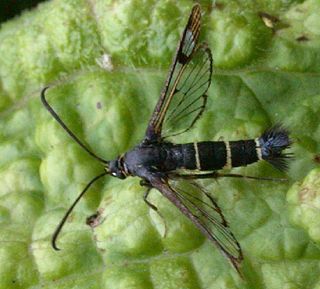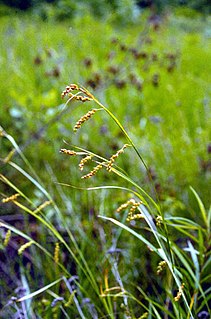
The Arctiinae are a large and diverse subfamily of moths with around 11,000 species found all over the world, including 6,000 neotropical species. This subfamily includes the groups commonly known as tiger moths, which usually have bright colours, footmen, which are usually much drabber, lichen moths, and wasp moths. Many species have "hairy" caterpillars that are popularly known as woolly bears or woolly worms. The scientific name Arctiinae refers to this hairiness. Some species within the Arctiinae have the word "tussock"' in their common names because they have been misidentified as members of the Lymantriinae subfamily based on the characteristics of the larvae.

The Sesiidae or clearwing moths are a diurnal moth family in the order Lepidoptera known for their Batesian mimicry in both appearance and behaviour of various Hymenoptera.

The Arctiini are a tribe of tiger moths in the family Erebidae.

The Adelidae or fairy longhorn moths are a family of monotrysian moths in the lepidopteran infraorder Heteroneura. The family was first described by Charles Théophile Bruand d'Uzelle in 1851. Most species have at least partially metallic patterns coloration and are diurnal, sometimes swarming around the tips of branches with an undulating flight. Others are crepuscular and have a drab coloration. Fairy longhorn moths have a wingspan of 4–28 millimeters, and males often have especially long antennae, 1–3 times as long as the forewing.

Halysidota tessellaris, also called the pale tiger moth, banded tussock moth, and tessellated halisidota, is in the family Erebidae and the tribe Arctiini, the tiger moths. The species was first described by James Edward Smith in 1797. Like many related species, adult moths have chemical defenses acquired from its host plants, in this case, alkaloids. Larval behaviors suggest that they are chemically protected; they have not been analyzed for alkaloid content.

Halysidota is a genus of moths in the family Erebidae. The genus was erected by Jacob Hübner in 1819.

Masdevallia davisii, or Davis' masdevallia, is a species of the orchid genus Masdevallia. It is also known as the orchid of the sun and was known to the Incas as qoriwaqanki – due to its similarity in form to the red Masdevallia veitchiana, known as waqanki.

Drasteria is a genus of moths in the family Erebidae.

Halysidota harrisii, the sycamore tussock moth, is a moth of the family Erebidae and the tribe Arctiini, the tiger moths. The species was first described by Benjamin Dann Walsh in 1864. It is found in southeastern Canada, the eastern parts of the United States, and northeastern Mexico.

Halysidota interlineata is a moth of the family Erebidae first described by Francis Walker in 1855. It is found in Costa Rica, Guatemala, Panama, Belize, Colombia, Venezuela, Surinam, French Guiana, Brazil and Uruguay.

Cymopterus davisii is a species of flowering plant in the carrot family known by the common name Davis's springparsley. This small, flat, taprooted perennial is endemic to Idaho in the United States, where it occurs in the Albion Mountains. The plant is found in the Albion Division of the Minidoka Ranger District of Sawtooth National Forest. It reaches approximately 7 in (18 cm) in height with a short stem that is sheathed by fibrous leaf bases. Numerous leaves form a whorl around yellow-flowered umbels.
Halysidota cinctipes, the gartered halysidota or Florida tussock moth, is a species of moth in the family Erebidae. It was described by Augustus Radcliffe Grote in 1865. It is found on Cuba, Haiti, the Bahamas and in the US states of Florida, Texas, Arizona and California. The range possibly extends through Mexico, Guatemala, Costa Rica and Panama to Venezuela, Brazil and Peru.
Halysidota leda is a moth of the family Erebidae. It was described by Herbert Druce in 1890. It is found on Dominica, Guadeloupe and Martinique. The habitat consists of hygrophilic (moist) and mesophilic areas.
Halysidota schausi, or Schaus' tussock moth, is a species of moth in the family Erebidae. It was described by Walter Rothschild in 1909. It is found from Texas and Mexico to Costa Rica, Guatemala, Colombia, Venezuela, Ecuador and Peru. It is also found on Martinique and the Lesser Antilles.
Halysidota steinbachi is a moth of the family Erebidae. It was described by Walter Rothschild in 1909. It is found in Argentina, Bolivia and Brazil.
Halysidota tucumanicola is a moth of the family Erebidae. It was described by Embrik Strand in 1919. It is found in Argentina.
Halysidota underwoodi, or Underwood's tussock moth, is a moth of the family Erebidae. It was described by Walter Rothschild in 1909. It is found in Mexico, Guatemala, Nicaragua, Costa Rica, Panama, Colombia, Venezuela, Ecuador, Peru and Bolivia.
Erigeron davisii is a North American species of flowering plant in the family Asteraceae known by the common name Davis's fleabane . It has been found only in Idaho and in northeastern Oregon.

Carex davisii, known as Davis' sedge or awned graceful sedge, is a species of Carex native to North America. It is listed as an endangered, threatened, or species of concern across much of edge of its range. It was named in the 1820s by Lewis David de Schweinitz and John Torrey in honor of Emerson Davis (1798–1866), a Massachusetts educator and "enthusiastic student of the genus" Carex.











